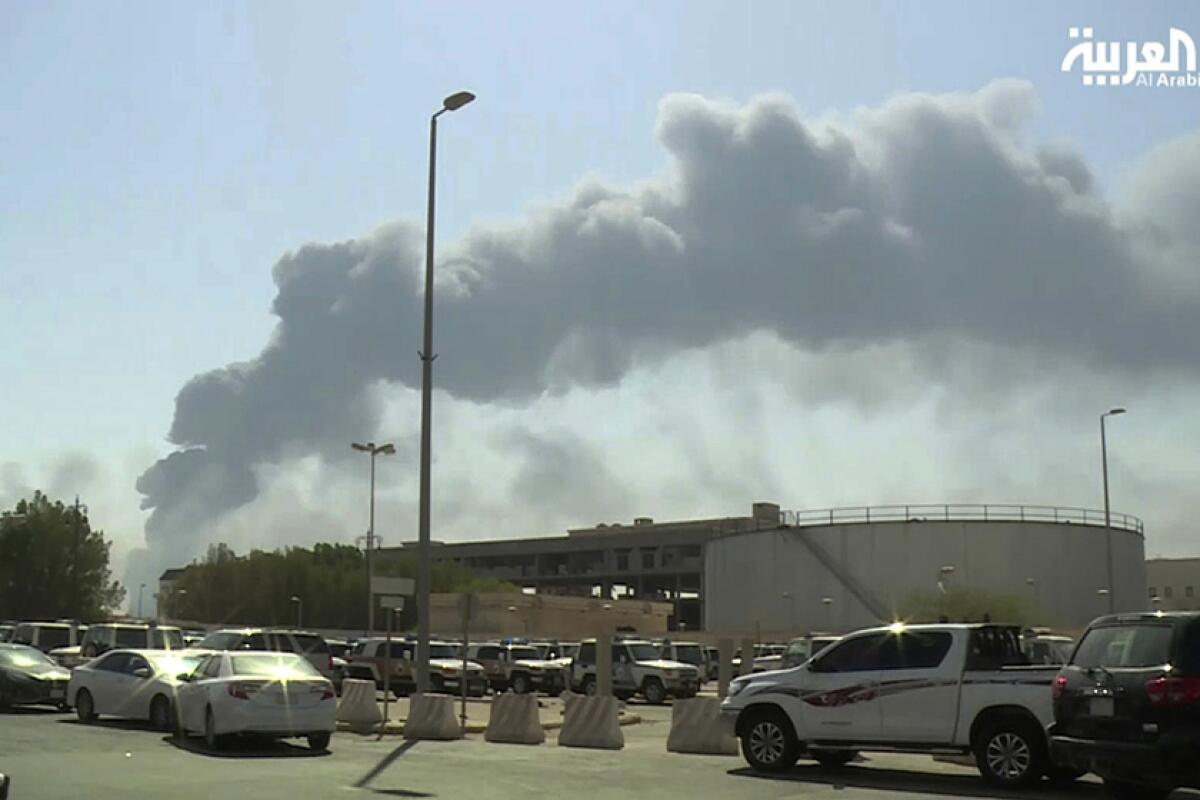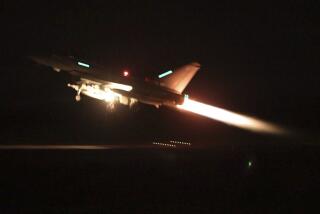Oil jumps the most ever after attack cuts Saudi Arabian supplies

- Share via
Global oil prices surged the most on record after a strike on a Saudi Arabian oil facility removed about 5% of global supplies, an attack the U.S. has blamed on Iran.
In an extraordinary start to trading, London’s Brent futures jumped almost $12 a barrel in the seconds after the open on Monday, the biggest intraday advance in dollar terms since they were launched in 1988. On the New York Mercantile Exchange, West Texas Intermediate contracts were frozen for about two minutes after the scale of the move delayed the market open.
While Brent futures pulled back after their initial surge of almost 20%, taking the global benchmark just shy of $72 a barrel, they were still headed for the biggest percentage gain since 2008.
The unprecedented move in oil reverberated around financial markets. Haven assets including gold, the yen and Treasuries surged on concern over the geopolitical fallout from the attacks. Currencies of commodity-linked nations including the Norwegian krone and the Canadian dollar also advanced. U.S. gasoline futures jumped almost 13%.
“The vulnerability of Saudi infrastructure to attacks, historically seen as a stable source of crude to the market, is a new paradigm the market will need to deal with,” said Virendra Chauhan, a Singapore-based analyst at industry consultant Energy Aspects Ltd. “At present, it is not known how long crude will be offline for.”
State energy producer Saudi Aramco lost about 5.7 million barrels per day of output on Saturday after 10 unmanned aerial vehicles struck the world’s biggest crude-processing facility in Abqaiq and the kingdom’s second-biggest oil field in Khurais.
For oil markets, it’s the single worst sudden disruption ever, surpassing the loss of Kuwaiti and Iraqi petroleum supply in August 1990, when Saddam Hussein invaded his neighbor. It also exceeds the loss of Iranian oil output in 1979 during the Islamic Revolution, according to the International Energy Agency.
Saudi Arabia can restart a significant volume of the halted oil production within days, but needs weeks to restore full output capacity, people familiar with the matter said. The kingdom — or its customers — may use stockpiles to keep oil supplies flowing in the short term. Aramco could consider declaring itself unable to fulfill contracts on some international shipments — known as force majeure — if the resumption of full capacity at Abqaiq takes weeks.
That would rattle oil markets and cast a shadow on Aramco’s preparations for what could be the world’s biggest initial public offering. It’s also set to escalate a showdown pitting Saudi Arabia and the U.S. against Iran, which backs proxy groups from Yemen to Syria and Lebanon. Iran-backed Houthi rebels in Yemen claimed credit for the attack, but President Trump and Secretary of State Michael R. Pompeo have already pointed the finger directly at Iran.
Trump, who said the U.S. is “locked and loaded depending on verification” that Iran staged the attack, earlier authorized the release of oil from the nation’s emergency oil reserves. The IEA, which helps coordinate industrialized countries’ emergency fuel stockpiles, said it was monitoring the situation.
“No matter whether it takes Saudi Arabia five days or a lot longer to get oil back into production, there is but one rational takeaway from this weekend’s drone attacks on the Kingdom’s infrastructure — that infrastructure is highly vulnerable to attack, and the market has been persistently mispricing oil,” Citigroup Inc.’s Ed Morse wrote in a research note.
Brent jumped more than 19% on ICE Futures Europe to $71.95 a barrel, its biggest gain in percentage terms since 1991. In the following hours, it pared that advance to trade 12% higher at $67.20 a barrel at 9:27 a.m. in Singapore.
Trading in WTI was frozen for a few minutes because of a so-called circuit breaker, which is triggered by a gain of more than 7%. When they finally opened, futures jumped as much as 15.5% to $63.34, the most since 2008.
More to Read
Inside the business of entertainment
The Wide Shot brings you news, analysis and insights on everything from streaming wars to production — and what it all means for the future.
You may occasionally receive promotional content from the Los Angeles Times.










